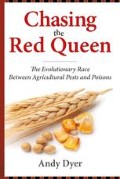Abstract
After an entire book describing the processes by which agricultural pest species evolve resistance, it should be clear to readers that the principles of evolutionary biology govern the world’s production of food and fiber. Even though many people working in agriculture understand these principles and the consequences of overusing chemicals, it would appear that the implications have not really been taken to heart. For example, the industry’s current focus is on creating crops that will attack insects by the internal production of a biochemical; the new strategy is essentially the same as the old one, and the results will be as predictable as ever. Chemical assaults on crop pests, no matter what the origin of the chemical, will stimulate adaptive responses from the pest species. The industry will remain in an evolutionary battle as it tries to counter each adaptive transformation by the pest with newer and “better” technological solutions. The treadmill that is the Red Queen will continue to move and we will continue to run as fast as possible just to stay in one place.
Notes
- 1.
R. H. Painter, Insect Resistance in Crop Plants (Lawrence, KS: University Press of Kansas, 1951).
- 2.
Ibid., viii.
- 3.
I. Heap, “International Survey of Herbicide Resistant Weeds,” August 1, 2014, www.weedscience.org/summary/Country.aspx.
- 4.
S. B. Powles and J. A. M. Holtum, “Herbicide-Resistant Weeds in Australia,” Proceedings of the 9th Australian Weeds Conference, Adelaide, South Australia, August 6–10, 1990, 185–93.
- 5.
E. Stokstad, “The War Against Weeds Down Under,” Science 341 (2013): 734–36.
- 6.
It is important to recognize that efforts in one industry can be compromised by efforts in another. In Australia, ryegrass seed production is an important component of the sheep and cattle industry, and active research and development programs continue to produce better and stronger ryegrass strains for animal forage. That industry battles growing disease and insect herbivory, and is now incorporating more biotechnology in the production of ryegrass. Of course, those efforts may contribute to the ongoing problems experienced by industries, such as the wheat industry, that view ryegrass as a major problematic weed.
- 7.
L. White Jr., “The Historical Roots of Our Ecological Crisis,” Science 155 (1967): 1203–7.
- 8.
W Jackson, New Roots for Agriculture (Lincoln, NE: University of Nebraska Press, 1980). Several subsequent books and collections of essays by Jackson address the multitude of topics contained in this book.
- 9.
J. A. Dewar, “Perennial Polyculture Farming: Seeds of Another Agricultural Revolution?” publication of the Rand Corporation, Pardee Center, 2007, www.rand.org/content/dam/rand/pubs/…/2007/RAND_OP179.pdf.
- 10.
Similar production has also been demonstrated at the Rodale Institute and the Woody Perennial Polyculture Research Site at the University of Illinois.
- 11.
Ray’s “Soil Health Page”: (http://vimeo.com/channels/raythesoilguy), his “Soil Stories” (www.nrcs.usda.gov/wps/portal/nrcs/detail/national/technical/?cid=STELPRDB1043490), and his “Dirt Diaries” (http://dirtdiaries.com/author/buz/) are examples of how these soil scientists are attempting to make informative and accessible videos about the importance of soil and the maintenance of its health and structure.
- 12.
University of California Agriculture and Natural Resources Statewide Integrated Pest Management Program, “What Is Integrated Pest Management (IPM)?” UC IPM Online, www.ipm.ucdavis.edu/GENERAL/whatisipm.html (revised July 2014).
- 13.
University of California Agriculture and Natural Resources, “UC IPM Pest Management Guidelines: Cotton,” Publication 3444 (revised May 2013).
- 14.
Ibid., 13.
- 15.
Ibid.
Rights and permissions
Copyright information
© 2014 Andy Dyer
About this chapter
Cite this chapter
Dyer, A. (2014). Integrated Systems and Long-Term Stability. In: Chasing the Red Queen. Island Press, Washington, DC. https://doi.org/10.5822/978-1-61091-520-5_14
Download citation
DOI: https://doi.org/10.5822/978-1-61091-520-5_14
Publisher Name: Island Press, Washington, DC
Print ISBN: 978-1-59726-536-2
Online ISBN: 978-1-61091-520-5
eBook Packages: Earth and Environmental ScienceEarth and Environmental Science (R0)

